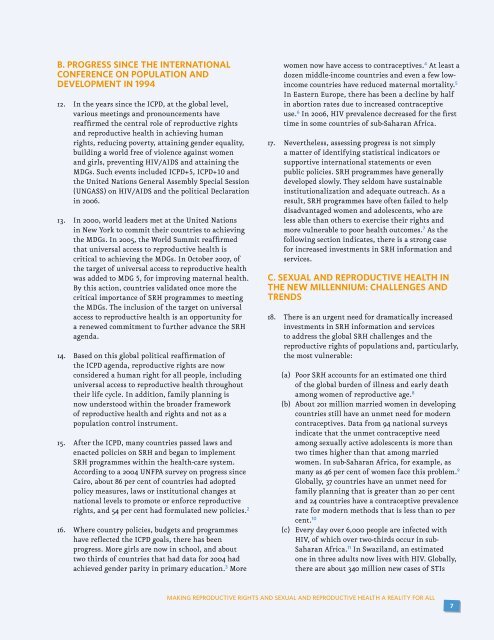Sexual and Reproductive Health Framework - UNFPA
Sexual and Reproductive Health Framework - UNFPA
Sexual and Reproductive Health Framework - UNFPA
You also want an ePaper? Increase the reach of your titles
YUMPU automatically turns print PDFs into web optimized ePapers that Google loves.
B. Progress since the InternationalConference on Population <strong>and</strong>Development in 199412. In the years since the ICPD, at the global level,various meetings <strong>and</strong> pronouncements havereaffirmed the central role of reproductive rights<strong>and</strong> reproductive health in achieving humanrights, reducing poverty, attaining gender equality,building a world free of violence against women<strong>and</strong> girls, preventing HIV/AIDS <strong>and</strong> attaining theMDGs. Such events included ICPD+5, ICPD+10 <strong>and</strong>the United Nations General Assembly Special Session(UNGASS) on HIV/AIDS <strong>and</strong> the political Declarationin 2006.13. In 2000, world leaders met at the United Nationsin New York to commit their countries to achievingthe MDGs. In 2005, the World Summit reaffirmedthat universal access to reproductive health iscritical to achieving the MDGs. In October 2007, ofthe target of universal access to reproductive healthwas added to MDG 5, for improving maternal health.By this action, countries validated once more thecritical importance of SRH programmes to meetingthe MDGs. The inclusion of the target on universalaccess to reproductive health is an opportunity fora renewed commitment to further advance the SRHagenda.14. Based on this global political reaffirmation ofthe ICPD agenda, reproductive rights are nowconsidered a human right for all people, includinguniversal access to reproductive health throughouttheir life cycle. In addition, family planning isnow understood within the broader frameworkof reproductive health <strong>and</strong> rights <strong>and</strong> not as apopulation control instrument.15. After the ICPD, many countries passed laws <strong>and</strong>enacted policies on SRH <strong>and</strong> began to implementSRH programmes within the health-care system.According to a 2004 <strong>UNFPA</strong> survey on progress sinceCairo, about 86 per cent of countries had adoptedpolicy measures, laws or institutional changes atnational levels to promote or enforce reproductiverights, <strong>and</strong> 54 per cent had formulated new policies. 216. Where country policies, budgets <strong>and</strong> programmeshave reflected the ICPD goals, there has beenprogress. More girls are now in school, <strong>and</strong> abouttwo thirds of countries that had data for 2004 hadachieved gender parity in primary education. 3 Morewomen now have access to contraceptives. 4 At least adozen middle-income countries <strong>and</strong> even a few lowincomecountries have reduced maternal mortality. 5In Eastern Europe, there has been a decline by halfin abortion rates due to increased contraceptiveuse. 6 In 2006, HIV prevalence decreased for the firsttime in some countries of sub-Saharan Africa.17. Nevertheless, assessing progress is not simplya matter of identifying statistical indicators orsupportive international statements or evenpublic policies. SRH programmes have generallydeveloped slowly. They seldom have sustainableinstitutionalization <strong>and</strong> adequate outreach. As aresult, SRH programmes have often failed to helpdisadvantaged women <strong>and</strong> adolescents, who areless able than others to exercise their rights <strong>and</strong>more vulnerable to poor health outcomes. 7 As thefollowing section indicates, there is a strong casefor increased investments in SRH information <strong>and</strong>services.C. <strong>Sexual</strong> <strong>and</strong> reproductive health inthe new millennium: challenges <strong>and</strong>trends18. There is an urgent need for dramatically increasedinvestments in SRH information <strong>and</strong> servicesto address the global SRH challenges <strong>and</strong> thereproductive rights of populations <strong>and</strong>, particularly,the most vulnerable:(a) Poor SRH accounts for an estimated one thirdof the global burden of illness <strong>and</strong> early deathamong women of reproductive age. 8(b) About 201 million married women in developingcountries still have an unmet need for moderncontraceptives. Data from 94 national surveysindicate that the unmet contraceptive needamong sexually active adolescents is more thantwo times higher than that among marriedwomen. In sub-Saharan Africa, for example, asmany as 46 per cent of women face this problem. 9Globally, 37 countries have an unmet need forfamily planning that is greater than 20 per cent<strong>and</strong> 24 countries have a contraceptive prevalencerate for modern methods that is less than 10 percent. 10(c) Every day over 6,000 people are infected withHIV, of which over two-thirds occur in sub-Saharan Africa. 11 In Swazil<strong>and</strong>, an estimatedone in three adults now lives with HIV. Globally,there are about 340 million new cases of STIsMAKING REPRODUCTIVE RIGHTS AND SEXUAL AND REPRODUCTIVE HEALTH A REALITY FOR ALL7
















